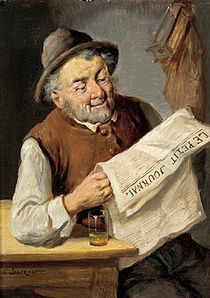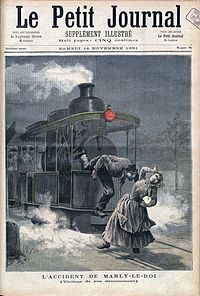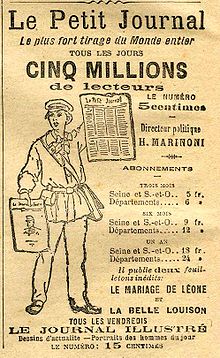Le Petit Journal
| Le Petit Journal | |
|---|---|

|
|
| description | daily newspaper |
| Area of Expertise | Tabloids |
| language | French |
| publishing company | Paris, France) |
| First edition | January 31, 1863 |
| attitude | August 27, 1944 |
| Frequency of publication | Every day |
| Sold edition | 1,000,000 copies |
| () | |
| editor | Moïse Millaud |
| ISSN |
1256-0464 |
Le Petit Journal was a Paris newspaper that appeared daily from 1863 to 1944. The daily newspaper was founded in 1863 by Moïse Polydore Millaud . At the turn of the century, the French press landscape was dominated by four newspapers. These were Le Petit Journal , Le Petit Parisien (1876), Le Matin (1885) and Le Journal (1892). They represent the golden age of the French press.
history
The banker and entrepreneur Moïse Polydore Millaud (born August 27, 1813 in Bordeaux ) founded his first newspaper Le Lutin in Bordeaux as early as 1833 .
Millaud had set himself the goal that his new newspaper Le Petit Journal should differ from other newspapers of the time essentially in price and the appearance. From the beginning, Millaud's goal was to get as high a circulation as possible.
The main goals were not to fixate on the usual political issues. Millaud directed his reporters to take to the streets to learn from public opinion. Continuation articles, miscellaneous, crime stories, international entanglements, horoscopes and sensations were published in the newspaper to encourage readers to buy the next issue. By avoiding the publication of political news, Millaud also circumvented the ten centime newspaper tax and was able to set the price of his newspaper at five centimes. In doing so, he made Le Petit Journal accessible to the poor.
The first edition of Le Petit Journal appeared on January 31, 1863 and was already the highest-circulation newspaper in Paris at the time, with more than 83,000 copies in the magazine trade. The main type of distribution of the Le Petit Journal was no longer subscription, as with other competitors, but retail sales. Le Petit Journal was also published in a different and handy format (43 × 30 cm) compared to the competition and at a significantly lower price. While the other newspapers at that time cost between 15 and 20 centimes , Le Petit Journal sold their newspaper for five centimes (French: a "sou"). Some securities in the Le Petit Journal newspaper show a 5 centime coin in the lower margin of the paper (see stock illustration opposite). It became the trademark of Le Petit Journal.
In 1869, Le Petit Journal was able to increase its September circulation from around 357,000 to 594,000 copies with the series of articles about the eightfold murderer Jean-Baptiste Troppmann . The Troppmann affair led to the breakthrough of Le Petit Journal.
Until his death, Millaud himself wrote articles in his newspapers under the pseudonym Duallim . Millaud died in Paris on October 13, 1871.
After Millaud's death in 1871, Émile de Girardin initially took over the management of the publishing house. In 1882, Hippolyte Auguste Marinoni took over Le Petit Journal . In addition to being an expert in printing mechanization, Marinoni was also a newspaper manager. In 1883 Marinoni commissioned Pierre Giffard with the task of redesigning the newsroom. Giffard kept a successful diary which was published under the pseudonym Jean Sans Terre in the Le Petit Journal. In 1884 a weekly illustrated supplement appeared. The color display was an innovation from Le Petit Journal, with additional front pages in color showing accidents, crimes and tragedies. The format difference (43 × 30) was abandoned in 1890, Palmer justified this with the abolition of the paper tax in 1886. Giffard began to organize public promotions for the newspaper.
- 1891, the first long-distance bicycle race Paris – Brest – Paris
- 1892, the 380 km Paris-Belfort marathon
- 1894, the world's first Paris-Rouen car race
- 1896, the first Paris marathon over 40 kilometers
Le Petit Journal reported on each event in a series of articles. The public followed the races and their participants in the editions published through them. The circulation increased steadily.
- Title pages (selection)
Accident in Marly-le-Roi in 1891
The title page of the edition of August 6, 1894 shows the exhibition of the participating vehicles before the Paris-Rouen race
1895 edition of the Dreyfus Affair
In the 1890s, at the height of its popularity, the newspaper had a circulation of over a million copies.
The circulation of Le Petit Journal began to dwindle from 1898. From 1936 the Petit Journal was the organ of the right-wing conservative nationalist Parti social français (PSF, French Social Party). In 1937 the circulation was only 150,000 copies. Despite repeated sponsorship of Raymond Patenôtre , publisher and later Minister for National Economy from April 10, 1938 to September 15, 1939 in the government of Édouard Daladier , the decline was accentuated in the period between the world wars. The committed position of editor-in-chief Ernest Judet against Dreyfus in the Dreyfus affair was named as the actual cause of the decline in circulation . The title was adorned with the motto “ Travail, Famille, Patrie ”, which had already been used by the Croix de Feu and which was adopted in 1940 by the Vichy regime. From 1940 the magazine was subsidized by the Vichy regime and ceased to appear in 1944.
Well-known authors and editors of the newspaper were: Albert Londres , René Hachette , Raymond Patenôtre , Saint-Paulien , Paul-Émile Victor , Daniel-Rops , Roger Vercel , Émile Gaboriau , Maxence Van der Meersch , Pierre Giffard and Ernest Judet .
All editions of Le Petit Journal are archived in the National Library of France .
literature
- Claude Bellanger, Jacques Godechot, Pierre Renouvin: Histoire générale de la presse française. Volume III: 1871-1940. Presses Univ. de France, Paris 1972, OCLC 58588120 .
Web links
- Le Petit journal (Paris. 1863) on gallica.bnf.fr (all edition years 1863 to 1944)
- Histoire on cent.ans.free.fr (French)
- Création du Petit Journal on archivesdefrance.culture.gouv.fr (French)
Individual evidence
- ↑ Le petit journal on st-just.com
- ^ Pierre Albert: Petit Journal Le In: Encyclopædia Universalis.
- ^ Francois Bayle: Le livre des richesses. 1979, ISBN 2-86418-049-9 .
- ↑ Specimen copy first edition 1863 on gallica.bnf.fr
- ^ Emile Zola: La Presse Parisienne. In: Etudes de presse. 15-16, 1956 ISSN 0246-1889 , p. 276.
- ^ SA du Le Petit Journal. on historical-wertpapiere.de
- ↑ Sylvia Valentin: 3. Le Petit Journal, the beginning of the mass press. In: Journalism in France in the 19th Century, Changes in the Press World in Critical Dialogue. (= Diploma thesis, Vienna 2000, chapter 3.)
- ↑ Éric Le Ray: Marinoni et lÂ'innovation technique - La Revue n ° 41 - May 2004 ( Memento of June 12, 2007 in the Internet Archive )
- ↑ Michael B. Palmer: Des petits journaux aux grands agences. Aubier, Paris 1983, p. 18.
- ↑ Paris to Belfort - 1892 ( Memento of April 29, 2012 in the Internet Archive ) in Ultra Leg (English)
- ↑ Première compétition automobile: Paris-Rouen 1894 on histomobile.com (French)
- ^ Pierre Albert: Histoire de la presse. op. cit. , P. 69.





